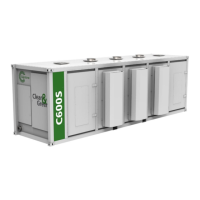Capstone Turbine Corporation • 16640 Stagg Street • Van Nuys • CA 91406 • USA
Installation Guide: Capstone C1000S/C800S/C600S with C1000 Series Controller
480064 Rev C (December 2018) Page 62 of 122
Capstone reserves the right to change or modify, without notice, the design, specifications, and/or contents of this document without
incurring any obligation either with respect to equipment previously sold or in the process of construction.
During normal operation, vacuum pressures may exist upstream of the compressor
which can result in condensate ingestion by the gas compressor. Addition of condensate
level switches and a small pump to remove the condensate or an additional container
and valves on the drain line to isolate the liquid from the vacuum may prevent
condensate ingestion.
Timer-based drainage systems are common in many applications. Even if a fully-
automatic drainage system is in place, all condensate traps on the drain line should have
a bypass available for manual draining.
If an installation will be operated without oversight for any length of time, the drainage
system should also include high-level switches as alarms to cease operation of the
overall installation in the event that some portion of the drainage system fails.
6.5.4. Low Temperature Concerns
Planning for a proper fuel conditioning system must take into account both the hottest and the
coldest ambient temperatures that will be encountered at the site. This planning is critical for
installations operating in regions experiencing very cold climates that might otherwise freeze
condensate in separation vessels, drip legs, or drain lines.
A clogged condensate removal system may result in passing condensate to downstream
components such as compressors or microturbines. Adding seasonally-operated heat tracing to
any component with potential for clogging the condensate removal system helps prevent system
failure.
An operating microturbine will easily maintain heating of internal fuel system components due to
the constant fuel flow. When a microturbine is stopped, the fuel temperature drops, condensing
liquid onto pipe walls which can gather at low points and eventually freeze. On restart, there may
be a clogged fuel line or stuck fuel control valve. Adding internal heating to the microturbine fuel
system may be required in cold environments where ice buildup in fuel system components
impacts ability to start.
6.5.5. Hydrogen Sulfide (H
2
S)
Hydrogen sulfide is a common and naturally occurring compound found in oil & gas production.
The concentration can vary widely in different fuels. Fuels containing hydrogen sulfide are referred
to as “sour”, in reference to the odor of H
2
S at low concentration.
The levels of hydrogen sulfide (H
2
S), carbon dioxide (CO
2
), and gas moisture content in a fuel is
specific to site and application and will impact maintenance intervals and the life of installed
compressors. Many compressors will use specific oils intended to both lubricate the compressor
and provide some degree of protection against corrosion.
Hydrogen sulfide is corrosive to metals and sealing materials, with some materials being more
corrosion-resistant than others. Selection of both microturbine model and each component of a
fuel conditioning system will be impacted by the level of H
2
S content in the fuel. Capstone
microturbines can handle varying amounts of H
2
S, and the specific limits for each product line are
described in the C1000S Product Specification (Table 1). Do not use galvanized steel, copper, or
brass components if the fuel contains H
2
S.

